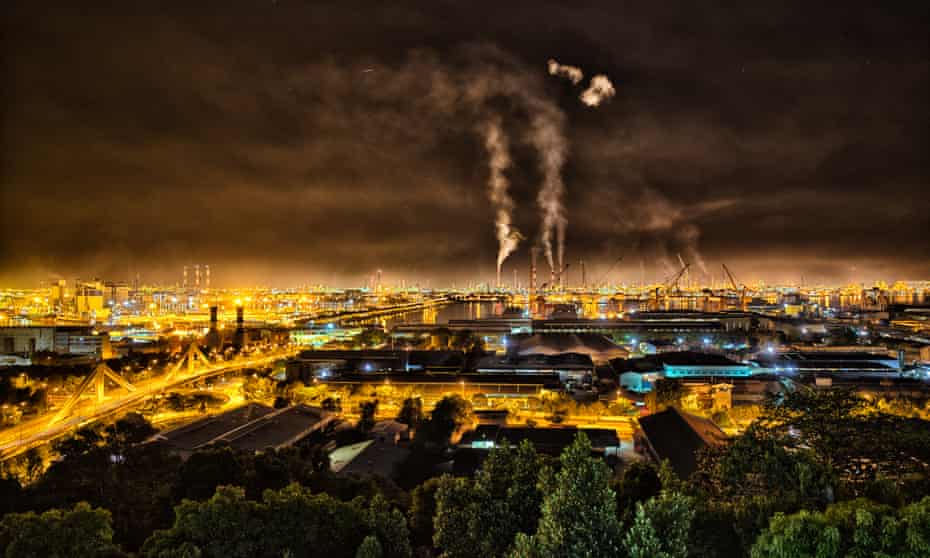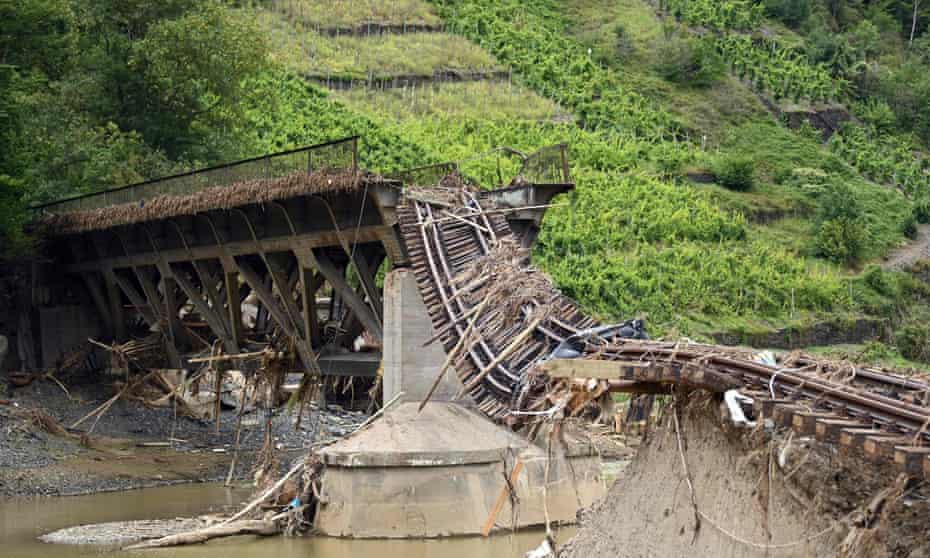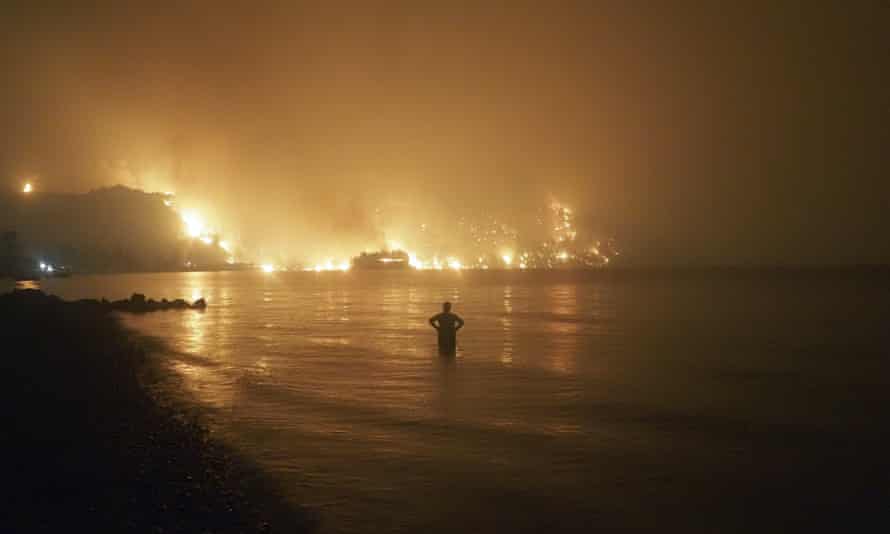
Atmospheric pressure … Jurong Island, Singapore.
Photograph: Terence Chiew/National Geographic Your Shot
A personal account of one climate scientist’s struggle to promote facts in the face of contrarian prejudice
Philip Ball
Sat 9 Oct 2021
How on earth did we get here? How did we arrive in a world where temperatures in British Columbia can come within a whisker of 50C, where a ring of fire made Athens look apocalyptic, massive floods ripped apart towns in Belgium and Germany – yet still there is no international plan for how to keep the world habitable by the end of the century, and those protesting about that are labelled extremists?
Hot Air, by the leading climate scientist Peter Stott, offers an explanation. On the one hand it details the four-decade journey taken by him and his peers, especially in the Intergovernmental Panel on Climate Change (IPCC), to determine whether the world is genuinely heating at a dangerous rate, and if human activities are the primary cause. (It is, and they are.) On the other hand, it exposes the sustained efforts of a coalition of business lobbies, politicians, maverick scientists and contrarian attention-seekers to discredit and undermine that enterprise – efforts that continue even now, as the world literally burns.
We are approaching a point where those denialist efforts are more than cynical, irresponsible and self-interested: they are starting to look like crimes against humanity. But they alone do not explain why there has been such a lack of effective action against climate change. A few loudmouthed pundits and wrongheaded scientists do not wield such power. Their actions, and the lobbying of multinationals, would count for far less if they were not so eagerly embraced by politicians who, for short-term electoral gain, have shied away from taking difficult decisions. It remains unclear whether they will behave any differently at the Cop26 meeting in Glasgow this November, which some regard as pretty much our last hope of averting disaster.
The biggest value of Stott’s account is in giving the lie to the denialists’ accusation that climate scientists are (for reasons they never make clear) conjuring alarmist narratives from error-prone computer models and shoddy data. In contrast, he shows – sometimes in a little too much detail – how slowly and carefully the scientists have edged towards the current consensus since the 1980s, comparing temperature records from many sources, testing their models’ ability to reproduce past climate patterns, exploring their sensitivity to different assumptions, and looking for the distinctive “fingerprints” in climate data that can distinguish human-made from natural effects.
One of Stott’s key papers, published in Nature in 1999, reported such a telltale signature. As an editor of that journal since the late 1980s, I have witnessed the rigour with which such studies are conducted and reported. I have seen how the scientists bend over backwards to avoid leaping to conclusions, how they refuse to let their worst fears compromise their scientific caution. It wasn’t until 1995 that the IPCC was ready to declare that “The balance of evidence suggests a discernible human influence on global climate.” Its latest wording, though, leaves no doubt: “It is unequivocal that human influence has warmed the atmosphere, ocean and land.”
Some environmentalists argue that the scientists were too cautious and sounded the alarm too late. But Stott’s descriptions of the IPCC’s debates – hours spent wrangling over words like “substantial”, “likely” and “unequivocal” as delegates from nations such as Saudi Arabia with a vested interest in the status quo sought to dilute the message – show what a difficult task they faced. And it’s true, however, that every expression of uncertainty would be exploited relentlessly by merchants of doubt with no such qualms about rigour or honesty.
A personal account of one climate scientist’s struggle to promote facts in the face of contrarian prejudice
Philip Ball
Sat 9 Oct 2021
How on earth did we get here? How did we arrive in a world where temperatures in British Columbia can come within a whisker of 50C, where a ring of fire made Athens look apocalyptic, massive floods ripped apart towns in Belgium and Germany – yet still there is no international plan for how to keep the world habitable by the end of the century, and those protesting about that are labelled extremists?
Hot Air, by the leading climate scientist Peter Stott, offers an explanation. On the one hand it details the four-decade journey taken by him and his peers, especially in the Intergovernmental Panel on Climate Change (IPCC), to determine whether the world is genuinely heating at a dangerous rate, and if human activities are the primary cause. (It is, and they are.) On the other hand, it exposes the sustained efforts of a coalition of business lobbies, politicians, maverick scientists and contrarian attention-seekers to discredit and undermine that enterprise – efforts that continue even now, as the world literally burns.
We are approaching a point where those denialist efforts are more than cynical, irresponsible and self-interested: they are starting to look like crimes against humanity. But they alone do not explain why there has been such a lack of effective action against climate change. A few loudmouthed pundits and wrongheaded scientists do not wield such power. Their actions, and the lobbying of multinationals, would count for far less if they were not so eagerly embraced by politicians who, for short-term electoral gain, have shied away from taking difficult decisions. It remains unclear whether they will behave any differently at the Cop26 meeting in Glasgow this November, which some regard as pretty much our last hope of averting disaster.
The biggest value of Stott’s account is in giving the lie to the denialists’ accusation that climate scientists are (for reasons they never make clear) conjuring alarmist narratives from error-prone computer models and shoddy data. In contrast, he shows – sometimes in a little too much detail – how slowly and carefully the scientists have edged towards the current consensus since the 1980s, comparing temperature records from many sources, testing their models’ ability to reproduce past climate patterns, exploring their sensitivity to different assumptions, and looking for the distinctive “fingerprints” in climate data that can distinguish human-made from natural effects.
One of Stott’s key papers, published in Nature in 1999, reported such a telltale signature. As an editor of that journal since the late 1980s, I have witnessed the rigour with which such studies are conducted and reported. I have seen how the scientists bend over backwards to avoid leaping to conclusions, how they refuse to let their worst fears compromise their scientific caution. It wasn’t until 1995 that the IPCC was ready to declare that “The balance of evidence suggests a discernible human influence on global climate.” Its latest wording, though, leaves no doubt: “It is unequivocal that human influence has warmed the atmosphere, ocean and land.”
Some environmentalists argue that the scientists were too cautious and sounded the alarm too late. But Stott’s descriptions of the IPCC’s debates – hours spent wrangling over words like “substantial”, “likely” and “unequivocal” as delegates from nations such as Saudi Arabia with a vested interest in the status quo sought to dilute the message – show what a difficult task they faced. And it’s true, however, that every expression of uncertainty would be exploited relentlessly by merchants of doubt with no such qualms about rigour or honesty.

Railway tracks destroyed by flooding at Rech near Dernau, Germany,
August 2021. Photograph: Ina Fassbender/AFP/Getty Images
Indeed, those climate-change deniers have offered flimsy, ad hoc arguments accompanied by attacks on the integrity of their opponents. In one of the most depressing chapters, Stott recounts his experiences as a British envoy to the Russian Academy of Sciences in July 2004, where he and other experts, including the UK’s then chief scientific adviser David King, were pitched against a motley crew of climate sceptics that included wayward meteorologist (and now ardent anti-vaxxer) Piers Corbyn, who presented “a wild-eyed sales pitch for his outlandish … solar-based weather forecasting technique”.
It is, however, not Putin but his buddy the former US president Donald Trump, until January the most powerful climate-science denier in the world, whom Stott has in sights when he warns that: “For the safety of humanity on Earth, we can’t afford to have any more powerful leaders who promote the false belief of climate change denial.” Mercifully, Trump’s decision to withdraw from the 2015 Paris Aagreement on climate change has been reversed by Joe Biden, but only a fool would consider that battle over.
This is very much a personal account of one climate scientist’s journey, with little analysis or synthesis. Climate-change deniers appear merely as a succession of obstacles to the truth, not as a phenomenon that needs to be understood. It is not hard to fathom the motives of the oil companies, nor those of the conservative thinktanks they have funded, such as the George C Marshall Institute or the Koch Foundation. But in the UK such denialism is kept in the public eye by a small band of professional contrarians including James Delingpole, Sherelle Jacobs and Peter Hitchens via outlets such as the Telegraph, Spectator and Mail on Sunday – the same people and media that have argued against life-saving measures to prevent the spread of Covid-19. The Venn-diagram overlap on these two unrelated issues is so complete that we’re clearly looking at a psychological issue – a phobia, perhaps, of anything deemed to constrain personal liberty. Perhaps some “sceptics” are genuinely in denial, in the psychoanalytic sense of refusing to accept or confront aspects of reality so as to avoid potential feelings of discomfort. The pandemic really is scary, and climate change even more so.
Indeed, those climate-change deniers have offered flimsy, ad hoc arguments accompanied by attacks on the integrity of their opponents. In one of the most depressing chapters, Stott recounts his experiences as a British envoy to the Russian Academy of Sciences in July 2004, where he and other experts, including the UK’s then chief scientific adviser David King, were pitched against a motley crew of climate sceptics that included wayward meteorologist (and now ardent anti-vaxxer) Piers Corbyn, who presented “a wild-eyed sales pitch for his outlandish … solar-based weather forecasting technique”.
It is, however, not Putin but his buddy the former US president Donald Trump, until January the most powerful climate-science denier in the world, whom Stott has in sights when he warns that: “For the safety of humanity on Earth, we can’t afford to have any more powerful leaders who promote the false belief of climate change denial.” Mercifully, Trump’s decision to withdraw from the 2015 Paris Aagreement on climate change has been reversed by Joe Biden, but only a fool would consider that battle over.
This is very much a personal account of one climate scientist’s journey, with little analysis or synthesis. Climate-change deniers appear merely as a succession of obstacles to the truth, not as a phenomenon that needs to be understood. It is not hard to fathom the motives of the oil companies, nor those of the conservative thinktanks they have funded, such as the George C Marshall Institute or the Koch Foundation. But in the UK such denialism is kept in the public eye by a small band of professional contrarians including James Delingpole, Sherelle Jacobs and Peter Hitchens via outlets such as the Telegraph, Spectator and Mail on Sunday – the same people and media that have argued against life-saving measures to prevent the spread of Covid-19. The Venn-diagram overlap on these two unrelated issues is so complete that we’re clearly looking at a psychological issue – a phobia, perhaps, of anything deemed to constrain personal liberty. Perhaps some “sceptics” are genuinely in denial, in the psychoanalytic sense of refusing to accept or confront aspects of reality so as to avoid potential feelings of discomfort. The pandemic really is scary, and climate change even more so.

A wildfire approaches Kochyli beach near Limni, on Evia, Greece,
in August. Photograph: Thodoris Nikolaou/AP
More puzzling are the maverick scientists who throw their lot in with the denialist cause. Here again, though, there is a pattern of contrarianism. Before they became key climate-deniers, the environmental scientists Fred Singer and Patrick Michaels argued that ozone depletion had little or nothing to do with human activities, either. That case, too, was “scientific hokum”, Stott says. Yet denialism pays: Singer and Michaels have been generously supported by fossil-fuel companies. We now have coteries of scientists using the same tactics as some climate-change deniers to challenge the consensus on Covid-19: a cherry-picking of evidence, a mantra that “consensus has no role in science” (wrong), and a shameless determination to move on every time they are proved wrong, driving an exhausting game of whack-a-mole.
It’s likely that such voices speak to similar public audiences, too: to those prone to conspiracy theory and a sense of marginalisation. Already, Covid sceptics and climate sceptics are converging. These trends can’t be tackled just by more and better information, but by an understanding of the psychology involved.
How the BBC let climate deniers walk all over it
George Monbiot
The bigger challenge is to motivate concerted political action in the ever-shrinking window of time that remains. In 2004, Stott published a paper showing that extreme summer heatwaves like that of the previous year were made more likely by global heating – a breakthrough idea that extracted meaningful probabilistic information even though it is all but impossible to ascribe the causes of individual events. “Summer of scorching heat will be back”, The Times warned.
And it surely has been: if here in the UK we’re left wondering where summer went, it was a different story in North America and southern Europe. “The abnormal was becoming normal at a frightening pace”, Stott says of the 2019 European heatwave. All 10 of the hottest years on record have occurred since 2005; the hottest five have all been since 2015, and this year of extreme wildfires and soaring mercury will join them. There’s still time to avert the worst, but only if we both mandate and demand it from our leaders.
Hot Air: The Inside Story of the Battle Against Climate Change Denial is published by Atlantic (£18.99). To support the Guardian and the Observer buy a copy a guardianbookshop.com. Delivery charges may apply.
No comments:
Post a Comment